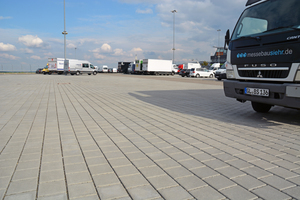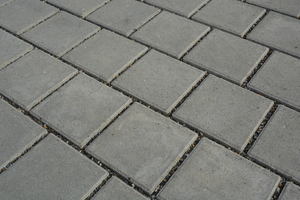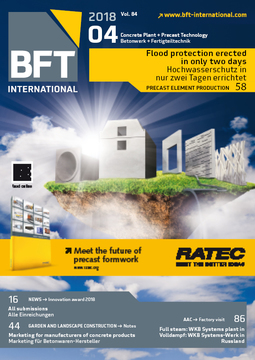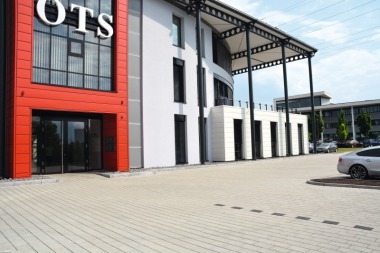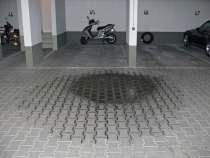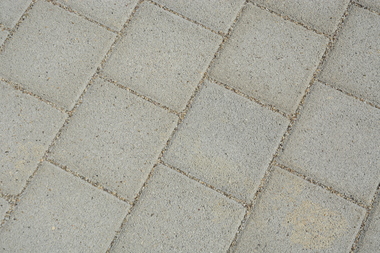Drainage-joint block pavement for parking facility at Messe Stuttgart
Messe Stuttgart, the exhibition and trade fair center of the capital of the German state of Baden-Württemberg, extends over an area of 105,200 m2 and is thus the tenth largest German exhibition facility, followed by Hamburg. 1.35 million people visited the venue in 2016 alone, and the number of exhibitors also reached an all-time high in the same year as center management welcomed 21,718 of them to Stuttgart. Likewise, the center’s degree of utilization grew to an unprecedented level in 2016. It thus comes as no surprise that the outdoor areas used for showcasing exhibits outside the halls and for parking purposes are also heavily frequented. A new type of concrete paving block with special properties was selected for resurfacing some of the areas that were originally covered with gravel chippings. This new pavement ensures that these heavily used areas remain visually appealing and structurally stable in the long term.
When this high-tech exhibition and trade fair center located at the Fildern – between the A8 highway and Stuttgart Airport – was inaugurated in October 2007, not all of the areas around the huge exhibition halls were covered with asphalt or concrete blocks. Instead, some sections were designed as water-bound surfaces. However, after ten years of heavy-duty service, center management found that these gravel-turf areas no longer met the requirements arising from operating the trade fair center and associated parking facilities.
“When we built Messe Stuttgart ten years ago, we only designed some of the outdoor areas for such heavy-duty use,” recalls Walter Braun, of Spiekermann GmbH Consulting Engineers, who contributed to the design of the facility. “Some outdoor facilities were thus covered with a 20 cm gravel-turf top course for environmental reasons. However, the situation is different now as areas are accessed by vehicles to a much larger degree than assumed originally. The truck movements inevitably associated with installing and dismantling large exhibits typically lead to depressions and rutting, which cause surface unevenness and puddles. The turf can thus hardly grow to the top, which makes these outdoor areas quite unsightly and poses risks to trade show visitors.”
Environmental requirements
To solve this problem, damaged areas have repeatedly been covered with gravel chippings in the past few years. However, this method requires a high amount of labor and expensive equipment, which is why Projektgesellschaft Neue Messe GmbH & Co. KG decided to lay a water-permeable block pavement on major portions of Parking Site 32, which was previously covered with a gravel-turf top course.
“Firstly, we were looking for a block pavement for this area of about 5,000 m² that would ensure its long-term structural stability and resistance to heavy traffic loads,” says Braun. “Secondly, we also had to fulfil certain environmental requirements, including the drainage of stormwater through this area into the groundwater table, instead of discharging it into the sewer system.”
Designers thus selected the 10 cm Einstein drainage-joint block pavement in a grey shade supplied by Betonwerk Diephaus. This 20 × 20 cm paver system excels with its superior performance characteristics. If at all, its “D point” (distance element) jointing technique results in only minimal, localized contact at the bottom paver edges in the case of butt-jointed installation. This design thus minimizes the contact zone between pavers. The commonly applied butt-jointed installation method can thus be avoided. The joint widths specified to absorb traffic loads are retained, and loads can be effectively transferred from paver to paver. For this reason, this system is capable of buffering shear and horizontal forces and to uniformly transfer them into the base courses. “This design ensures that the pavement remains undamaged in the long term,” Braun explains.
Drainage via 12 mm joints
Yet the selected block paver system also meets the environmental requirements specified for the parking site pavement. Its 12 mm wide joints ensure drainage through more than 10% of the paved surface. “We thus make sure that the stormwater can completely run off into the drainage gravel course via the wide joints between the blocks. Stormwater run-off is thus drained right on the spot. In each parking site section, a safety drainage channel was incorporated along the central axis and connected to the stormwater sewer. In the event of heavy rainfall causing water saturation of the ground, water can be discharged through the drainage gravel course and the safety drainage channel. Stormwater is thus retained prior to running off into the sewer,” Braun adds.
For stormwater drainage to work properly, designers selected a specific layout of the individual courses. “The paver bedding was designed as a 3 cm course consisting of 8-16 mm crushed chippings. Underneath, a 15 to 50 cm leveling course comprised of 0-45 mm gravel was laid above the frost subbase to ensure appropriate drainage. We largely eliminated ultrafine fractions, which ensures long-term water permeability,” Braun goes on to explain.
The new pavement not only meets functional specifications but also has a pleasant appearance: “The fact that vehicles are no longer parked in water-covered areas makes the newly surfaced sections visually appealing again, in keeping with the standard of a state-of-the-art, attractive exhibition center.”

